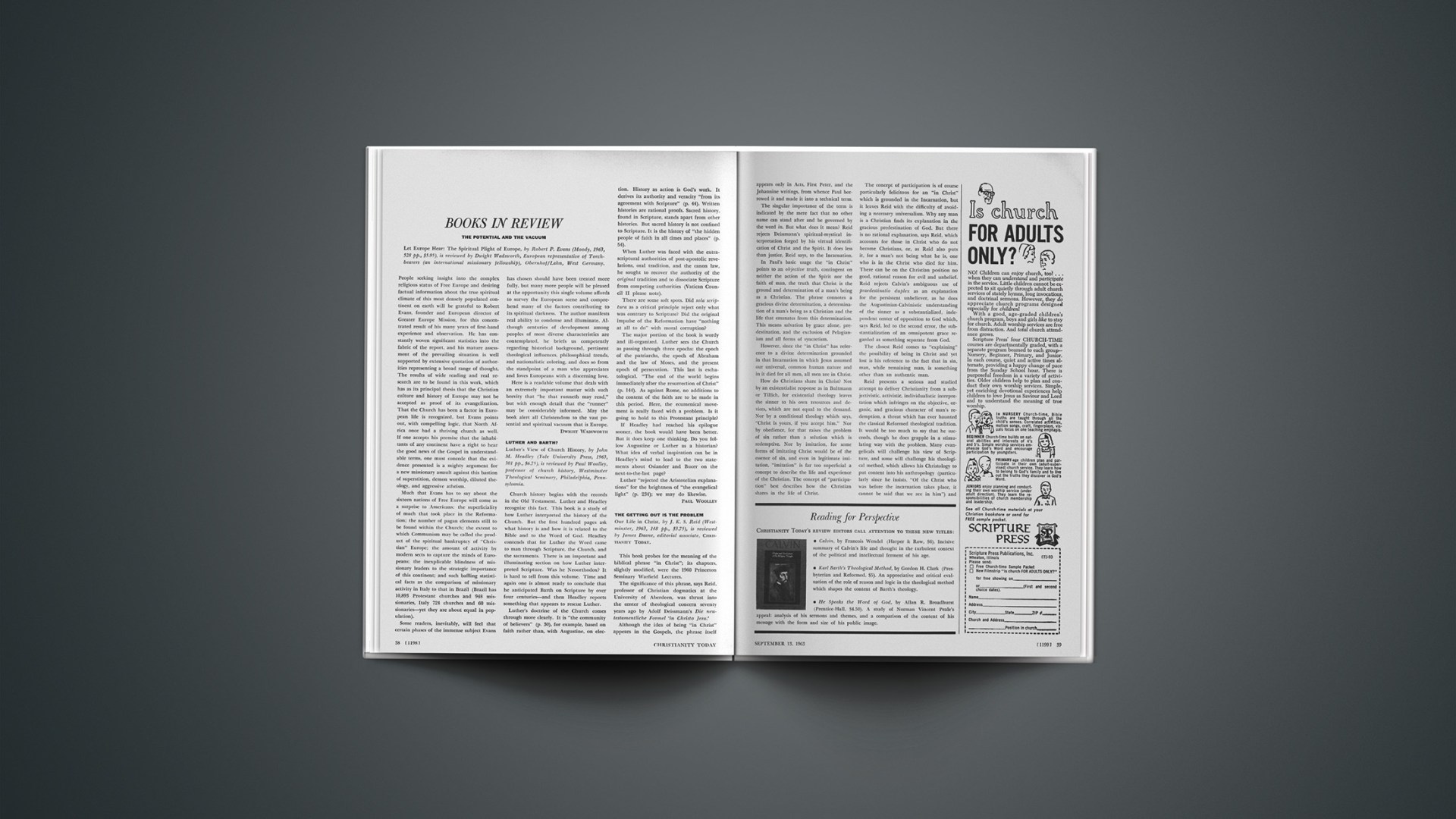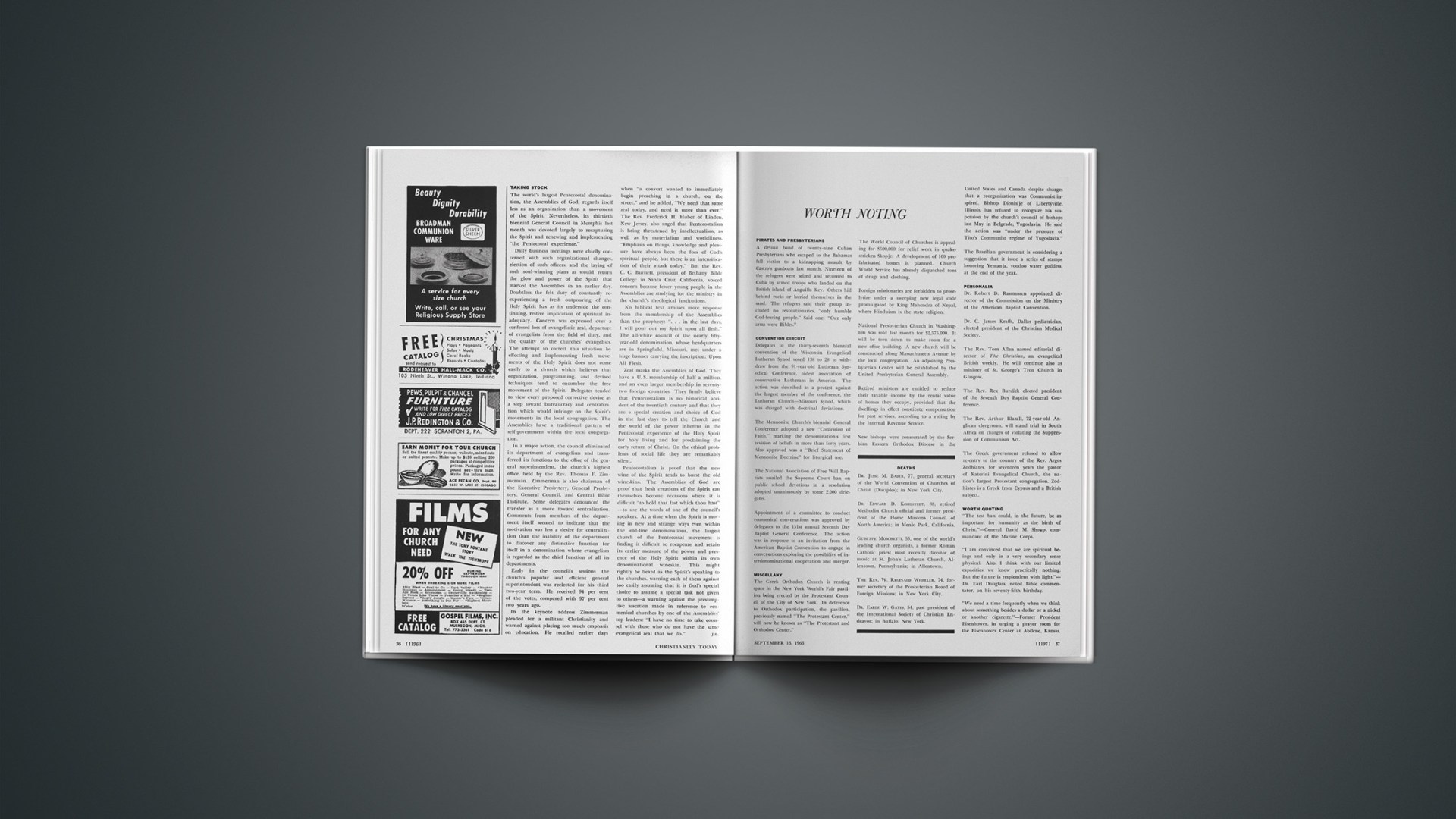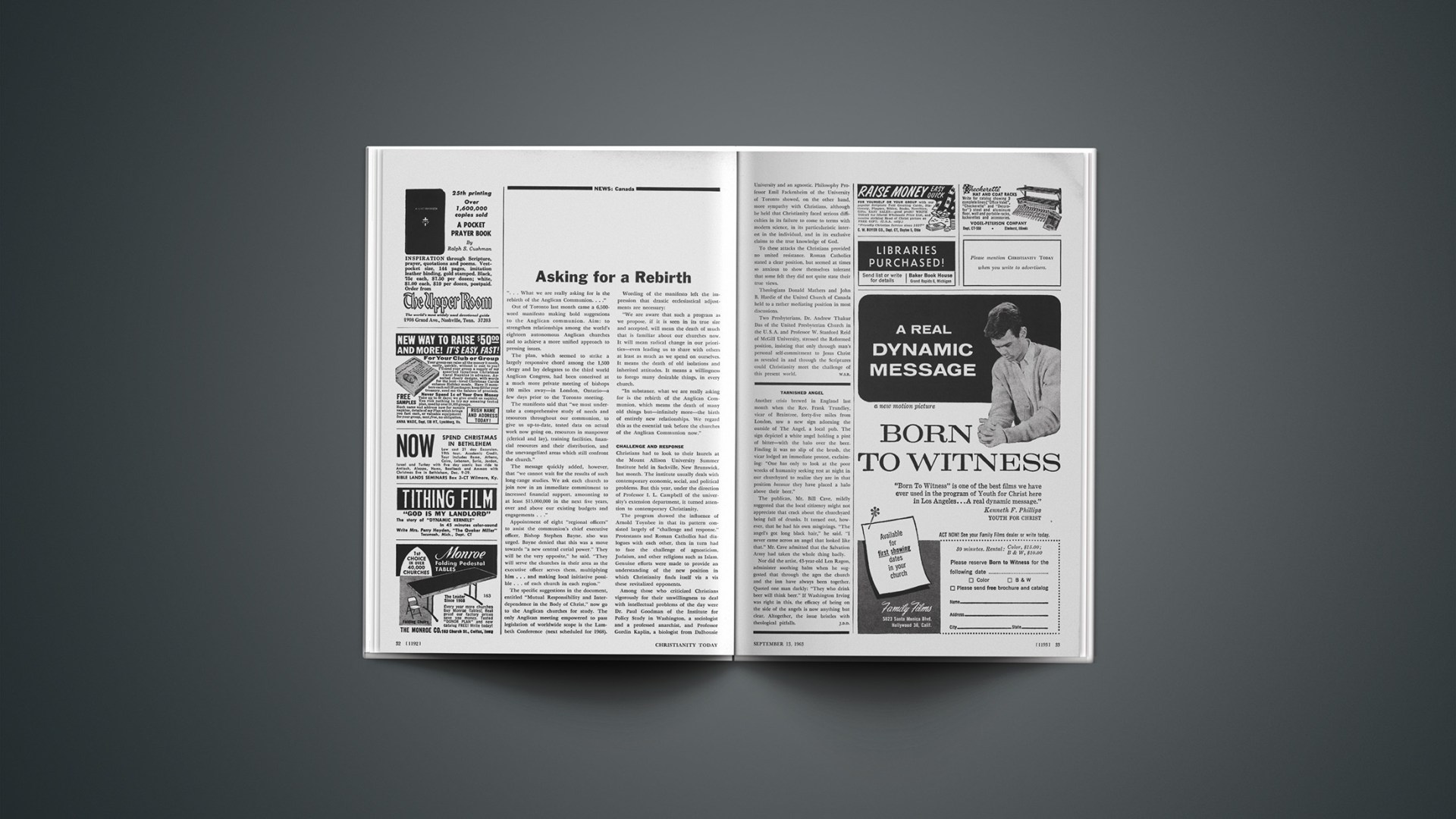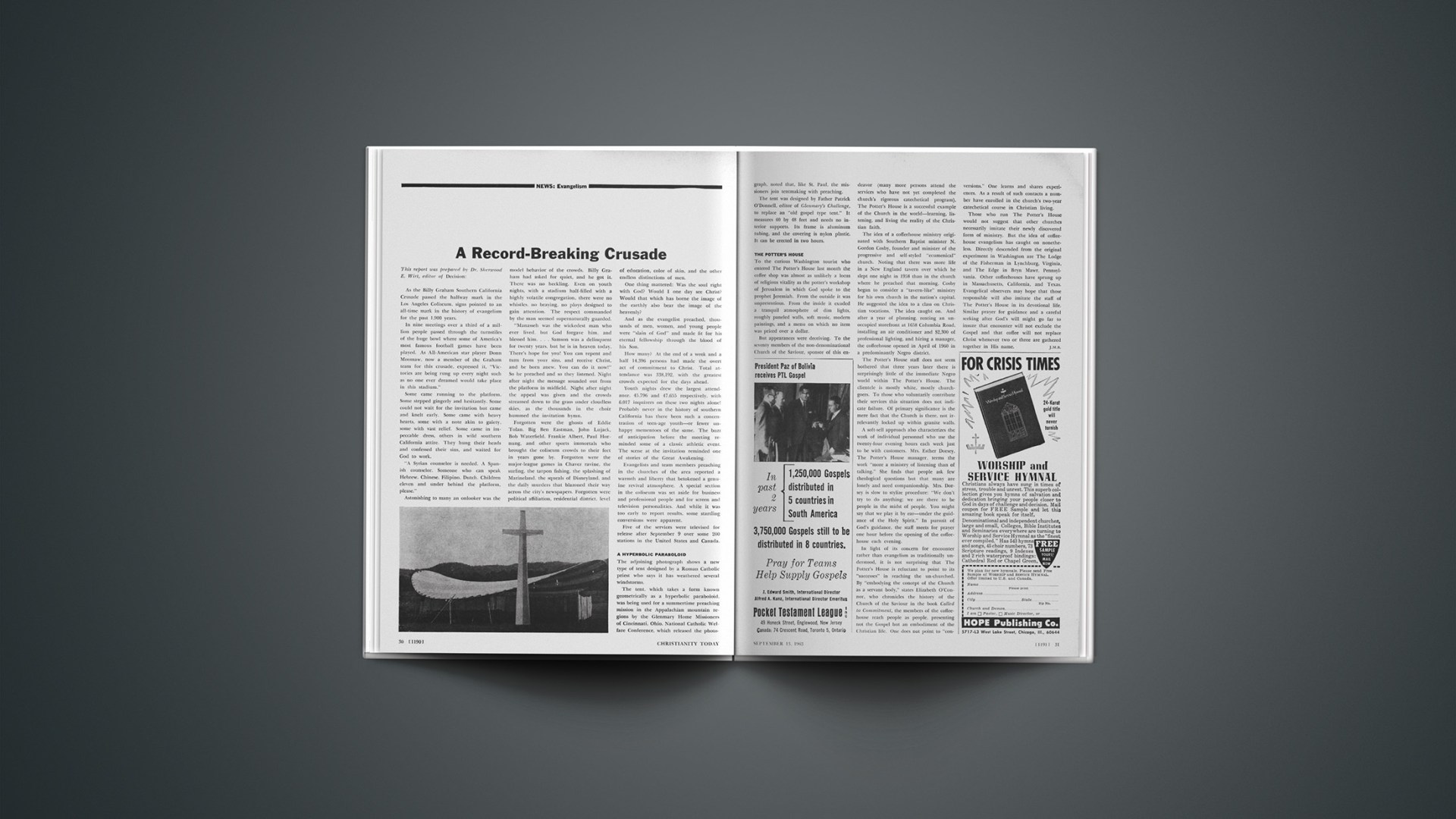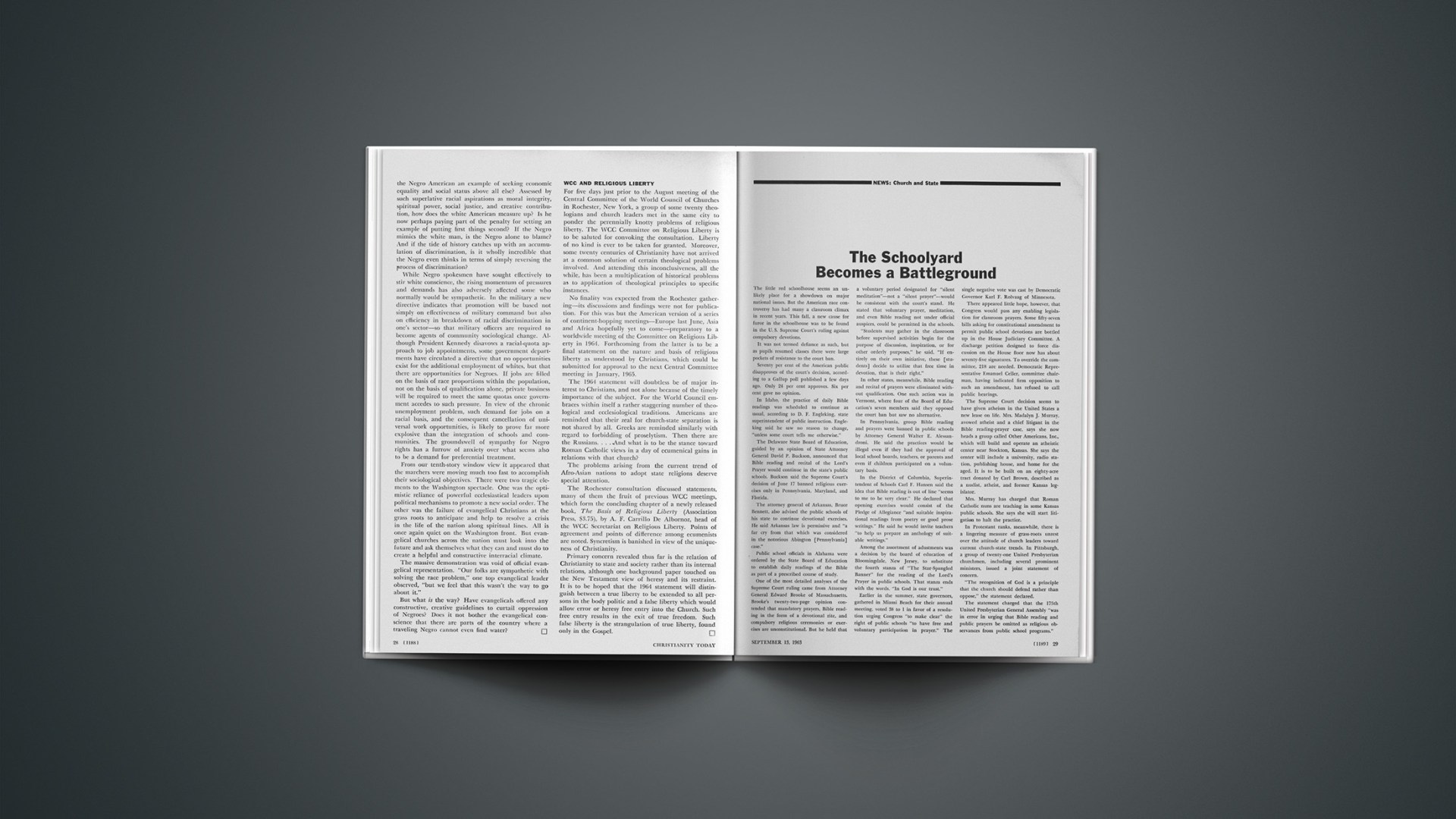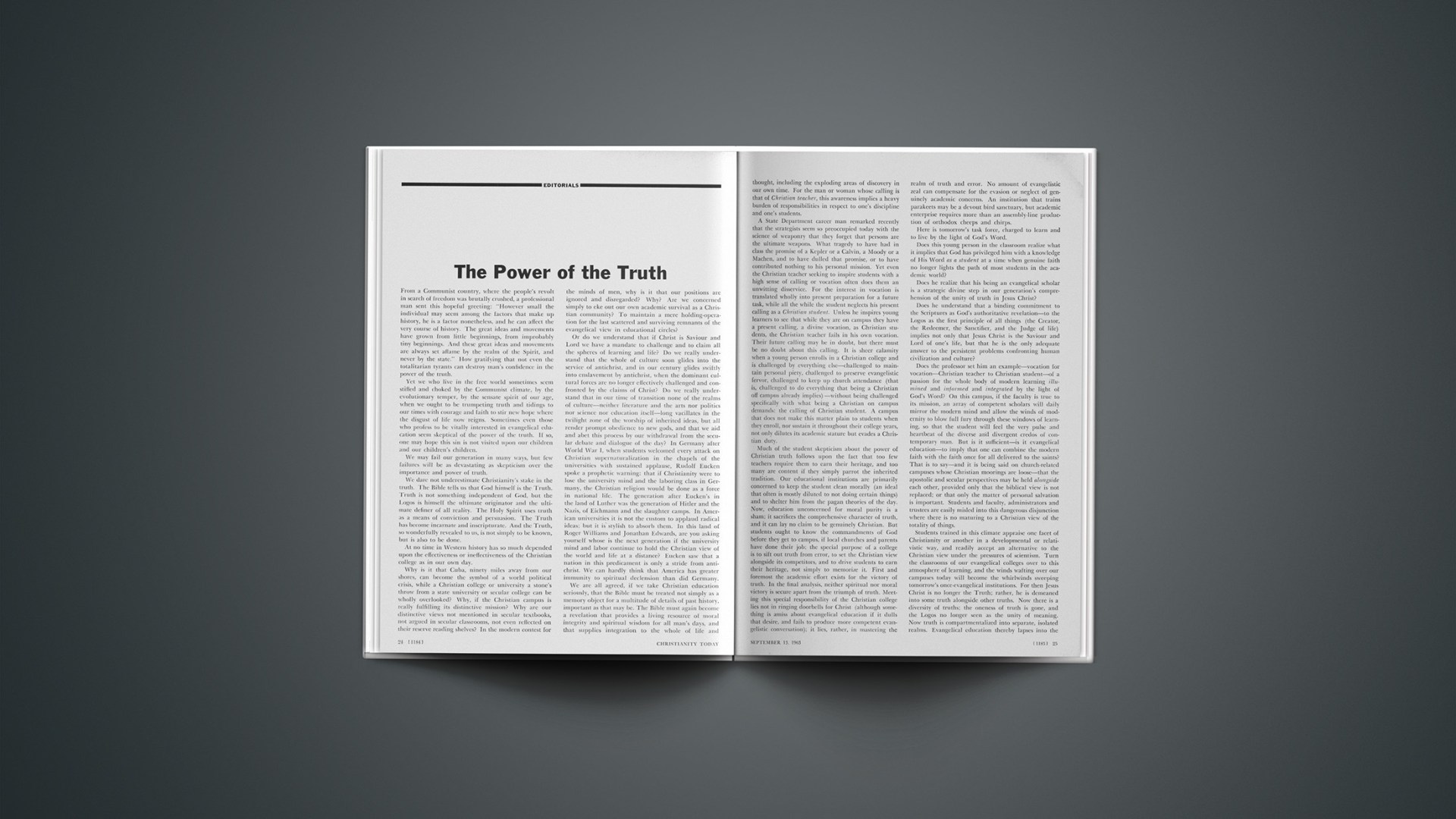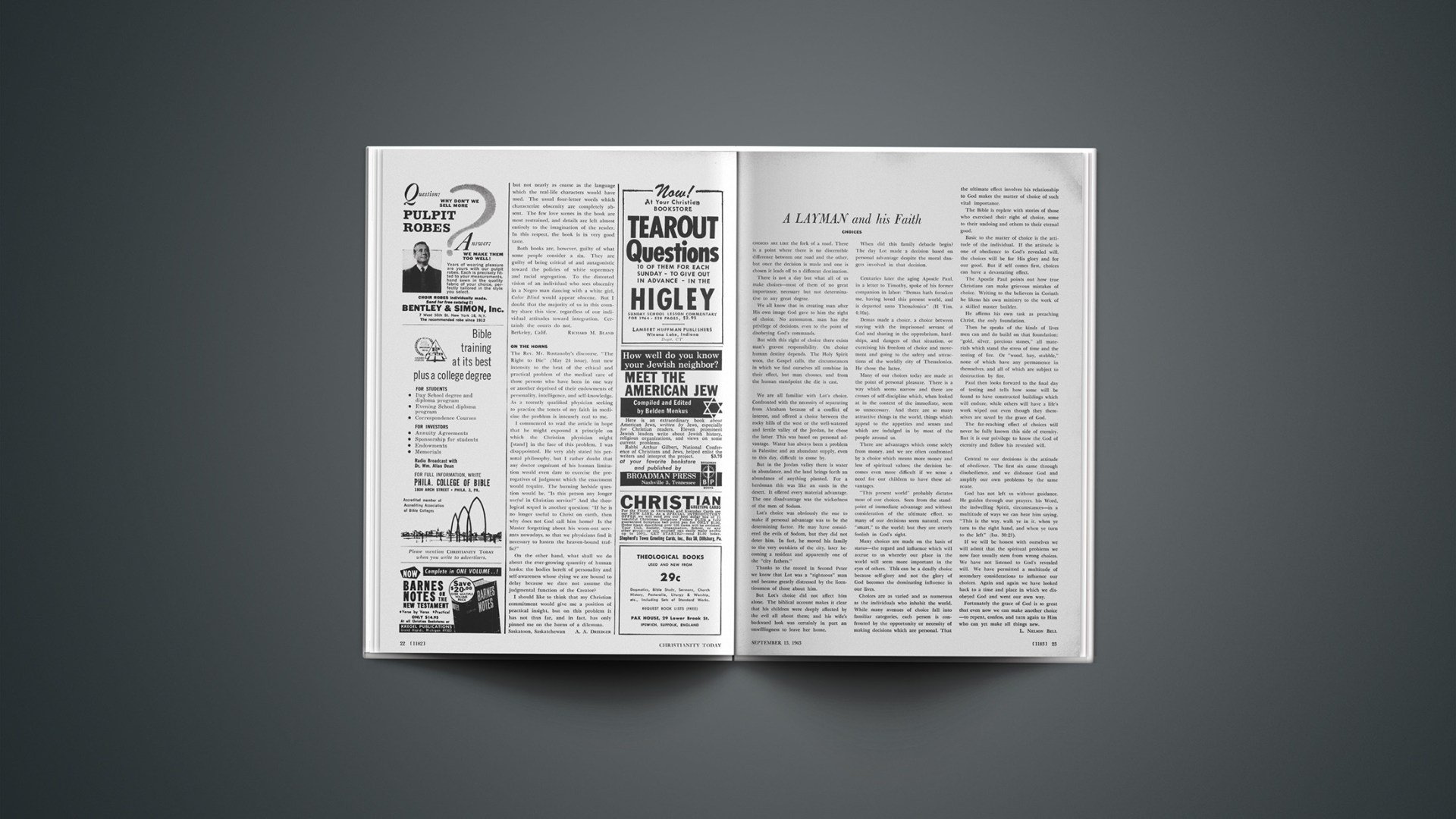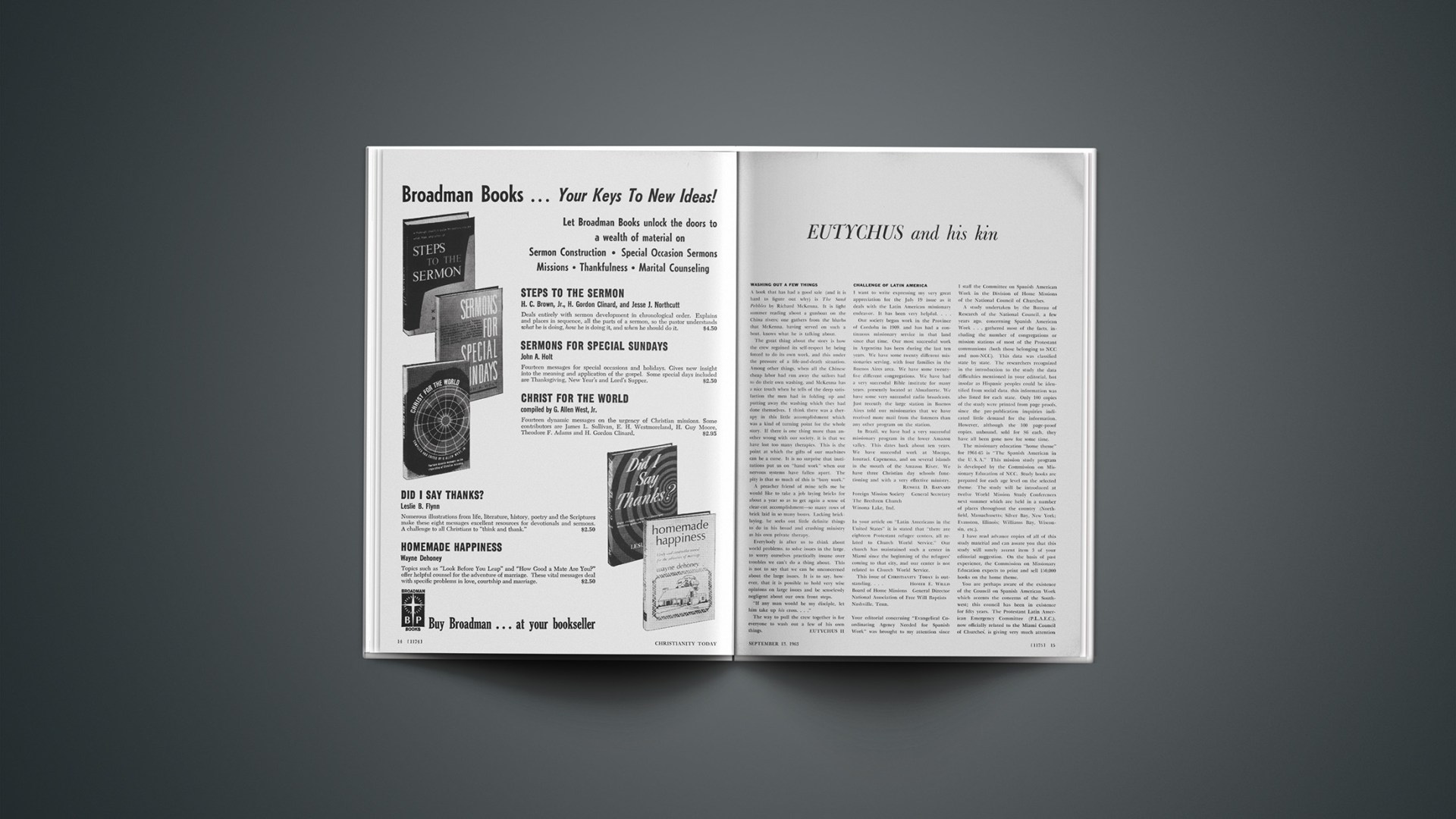The Potential And The Vacuum
Let Europe Hear: The Spiritual Plight of Europe, by Robert P. Evans (Moody, 1963, 528 pp., $5.95), is reviewed by Dwight Wadsworth, European representative of Torchbearers (an international missionary fellowship), Obernhof/Lahn, West Germany.
People seeking insight into the complex religious status of Free Europe and desiring factual information about the true spiritual climate of this most densely populated continent on earth will be grateful to Robert Evans, founder and European director of Greater Europe Mission, for this concentrated result of his many years of first-hand experience and observation. He has constantly woven significant statistics into the fabric of the report, and his mature assessment of the prevailing situation is well supported by extensive quotation of authorities representing a broad range of thought. The results of wide reading and real research are to be found in this work, which has as its principal thesis that the Christian culture and history of Europe may not be accepted as proof of its evangelization. That the Church has been a factor in European life is recognized, but Evans points out, with compelling logic, that North Africa once had a thriving church as well. If one accepts his premise that the inhabitants of any continent have a right to hear the good news of the Gospel in understandable terms, one must concede that the evidence presented is a mighty argument for a new missionary assault against this bastion of superstition, demon worship, diluted theology, and aggressive atheism.
Much that Evans has to say about the sixteen nations of Free Europe will come as a surprise to Americans: the superficiality of much that took place in the Reformation; the number of pagan elements still to be found within the Church; the extent to which Communism may be called the product of the spiritual bankruptcy of “Christian” Europe; the amount of activity by modern sects to capture the minds of Europeans; the inexplicable blindness of missionary leaders to the strategic importance of this continent; and such baffling statistical facts as the comparison of missionary activity in Italy to that in Brazil (Brazil has 10,893 Protestant churches and 948 missionaries, Italy 724 churches and 60 missionaries—yet they are about equal in population).
Some readers, inevitably, will feel that certain phases of the immense subject Evans has chosen should have been treated more fully, but many more people will be pleased at the opportunity this single volume affords to survey the European scene and comprehend many of the factors contributing to its spiritual darkness. The author manifests real ability to condense and illuminate. Although centuries of development among peoples of most diverse characteristics are contemplated, he briefs us competently regarding historical background, pertinent theological influences, philosophical trends, and nationalistic coloring, and does so from the standpoint of a man who appreciates and loves Europeans with a discerning love.
Here is a readable volume that deals with an extremely important matter with such brevity that “he that runneth may read,” but with enough detail that the “runner” may be considerably informed. May the book alert all Christendom to the vast potential and spiritual vacuum that is Europe.
DWIGHT WADSWORTH
Luther And Barth?
Luther’s View of Church History, by John M. Headley (Yale University Press, 1963, 301 pp., $6.75), is reviewed by Paul Woolley, professor of church history, Westminster Theological Seminary, Philadelphia, Pennsylvania.
Church history begins with the records in the Old Testament. Luther and Headley recognize this fact. This book is a study of how Luther interpreted the history of the Church. But the first hundred pages ask what history is and how it is related to the Bible and to the Word of God. Headley contends that for Luther the Word came to man through Scripture, the Church, and the sacraments. There is an important and illuminating section on how Luther interpreted Scripture. Was he Neoorthodox? It is hard to tell from this volume. Time and again one is almost ready to conclude that he anticipated Barth on Scripture by over four centuries—and then Headley reports something that appears to rescue Luther.
Luther’s doctrine of the Church comes through more clearly. It is “the community of believers” (p. 30), for example, based on faith rather than, with Augustine, on election. History as action is God’s work. It derives its authority and veracity “from its agreement with Scripture” (p. 44). Written histories are rational proofs. Sacred history, found in Scripture, stands apart from other histories. But sacred history is not confined to Scripture. It is the history of “the hidden people of faith in all times and places” (p. 54).
When Luther was faced with the extra-scriptural authorities of post-apostolic revelations, oral tradition, and the canon law, he sought to recover the authority of the original tradition and to dissociate Scripture from competing authorities (Vatican Council II please note).
There are some soft spots. Did sola scriptura as a critical principle reject only what was contrary to Scripture? Did the original impulse of the Reformation have “nothing at all to do” with moral corruption?
The major portion of the book is wordy and ill-organized. Luther sees the Church as passing through three epochs: the epoch of the patriarchs, the epoch of Abraham and the law of Moses, and the present epoch of persecution. This last is eschatological. “The end of the world begins immediately after the resurrection of Christ” (p. 144). As against Rome, no additions to the content of the faith are to be made in this period. Here, the ecumenical movement is really faced with a problem. Is it going to hold to this Protestant principle?
If Headley had reached his epilogue sooner, the book would have been better. But it does keep one thinking. Do you follow Augustine or Luther as a historian? What idea of verbal inspiration can be in Headley’s mind to lead to the two statements about Osiander and Bucer on the next-to-the-last page?
Luther “rejected the Aristotelian explanations” for the brightness of “the evangelical light” (p. 234); we may do likewise.
PAUL WOOLLEY
The Getting Out Is The Problem
Our Life in Christ, by J. K. S. Reid (Westminster, 1963, 148 pp., $3.75), is reviewed by James Daane, editorial associate,CHRISTIANITY TODAY.
This book probes for the meaning of the biblical phrase “in Christ”; its chapters, slightly modified, were the 1960 Princeton Seminary Warfield Lectures.
The significance of this phrase, says Reid, professor of Christian dogmatics at the University of Aberdeen, was thrust into the center of theological concern seventy years ago by Adolf Deissmann’s Die neutestamentliche Formel ‘in Christo Jesu.’
Although the idea of being “in Christ” appears in the Gospels, the phrase itself appears only in Acts, First Peter, and the Johannine writings, from whence Paul borrowed it and made it into a technical term.
The singular importance of the term is indicated by the mere fact that no other name can stand after and be governed by the word in. But what does it mean? Reid rejects Deissmann’s spiritual-mystical interpretation forged by his virtual identification of Christ and the Spirit. It does less than justice, Reid says, to the Incarnation.
In Paul’s basic usage the “in Christ” points to an objective truth, contingent on neither the action of the Spirit nor the faith of man, the truth that Christ is the ground and determination of a man’s being as a Christian. The phrase connotes a gracious divine determination, a determination of a man’s being as a Christian and the life that emanates from this determination. This means salvation by grace alone, pre-estination, and the exclusion of Pelagianism and all forms of syncretism.
However, since the “in Christ” has reference to a divine determination grounded in that Incarnation in which Jesus assumed our universal, common human nature and in it died for all men, all men are in Christ.
How do Christians share in Christ? Not by an existentialist response as in Bultmann or Tillich, for existential theology leaves the sinner to his own resources and devices, which are not equal to the demand. Nor by a conditional theology which says, “Christ is yours, if you accept him.” Nor by obedience, for that raises the problem of sin rather than a solution which is redemptive. Nor by imitation, for some forms of imitating Christ would be of the essence of sin, and even in legitimate imitation, “imitation” is far too superficial a concept to describe the life and experience of the Christian. The concept of “participation” best describes how the Christian shares in the life of Christ.
The concept of participation is of course particularly felicitous for an “in Christ” which is grounded in the Incarnation, but it leaves Reid with the difficulty of avoiding a necessary universalism. Why any man is a Christian finds its explanation in the gracious predestination of God. But there is no rational explanation, says Reid, which accounts for those in Christ who do not become Christians, or, as Reid also puts it, for a man’s not being what he is, one who is in the Christ who died for him. There can be on the Christian position no good, rational reason for evil and unbelief. Reid rejects Calvin’s ambiguous use of praedestinatio duplex as an explanation for the persistent unbeliever, as he does the Augustinian-Calvinistic understanding of the sinner as a substantialized, independent center of opposition to God which, says Reid, led to the second error, the substantialization of an omnipotent grace regarded as something separate from God.
The closest Reid comes to “explaining” the possibility of being in Christ and yet lost is his reference to the fact that in sin, man, while remaining man, is something other than an authentic man.
Reid presents a serious and studied attempt to deliver Christianity from a subjectivistic, activistic, individualistic interpretation which infringes on the objective, organic, and gracious character of man’s redemption, a threat which has ever haunted the classical Reformed theological tradition. It would be too much to say that he succeeds, though he does grapple in a stimulating way with the problem. Many evangelicals will challenge his view of Scripture, and some will challenge his theological method, which allows his Christology to put content into his anthropology (particularly since he insists, “Of the Christ who was before the incarnation takes place, it cannot be said that we are in him”) and which, on the other hand, allows his anthropology to throw light on his Christology (we may construe Christ as one who is able to function “as the one in whom man can be said to be”). But all this calls for a closer analysis than can be given here. Here it must suffice to say that man as the imago dei is, according to Reid, one for whom the destiny of being in Christ is possible, and Christ must be Christologically so construed as to be one in whom it is possible for man to exist. Reid constantly skirts the ontological question of Christ as the ground and reality of man’s existence, yet he never deals with it explicitly—and therefore (perhaps) once quotes but never deals with the Pauline assertion that “we are created in Christ Jesus.”
JAMES DAANE
Quick Survey
Theories of Revelation, by H. D. McDonald (Allen & Unwin, 1963, 384 pp., 37s. 6d.), is reviewed by Gordon H. Clark, professor of philosophy, Butler University, Indianapolis, Indiana.
As indicated by the subtitle, An Historical Study 1860–1960, this volume surveys the views of biblical critics on a number of important points.
The first two chapters are philosophic and scientific, describing the unsettling effect of Darwin, Spencer, Clifford, Freud. Tillich, Brunner, and Bultmann on belief in the Bible. The third chapter surveys higher criticism. The author then discusses the significance of Christ’s appeals to the Old Testament, and the critics’ theories of accommodation, kenosis, and “religious” versus “historical” intention. The remaining chapters run over the various views on the Scriptures and the Word, biblical inerrancy, biblical inspiration, biblical authority, and revelation and authority.
The chief defect of the book is no doubt its chief merit: it is a quick survey of a century of criticism. The historical development is competently spread before the reader, and the material is well worth having. Obviously the author is extremely well informed. Some 600 authors are mentioned, but of course only briefly. It might have been better to omit two-thirds of them in order to treat more adequately the more important writers. As it is, one tends to tire of the continuous cataloging.
The author has expressed his own views in another volume. Here it is hard to discern precisely what they are. He is very keen in uncovering the weaknesses and inconsistencies of the destructive critics; he exposes their persistent misrepresentation of the Reformation view of the Bible, and treats the orthodox scholars with reasonable respect. Then, too, it is clear that he demands objectivity in revelation. The subjectivity of Schleiermacher, of Harnack, of Barth is repudiated. Christianity cannot be based on experience; there must be a verbal message from God.
But the author does not clearly state that this verbal message is entirely true. In the Introduction he contrasts the view of revelation as a body of divinely communicated truths with the view that revelation existing ab extra is the wickedest of all follies. The impression left at the end of the book is that there must be some compromise between the extremes of objectivity and subjectivity.
GORDON H. CLARK
Illustrious Triumph
Christ’s Witchdoctor, by Homer E. Dowdy (Harper & Row, 1963, 241 pp., $3.95), is reviewed by R. Kenneth Strachan, general director, Latin America Mission, San Jose, Costa Rica.
It is encouraging to see the number of books on the missionary movement in Latin America gradually building up. Thanks to Homer Dowdy and Harper’s, a new chapter has been added to the story of the work among the lowland Indian tribes. As seen through North American eyes, this account of a witchdoctor’s conversion, resulting in the amazing transformation of the life of the Wai Wai in British Guiana, is another thrilling illustration of Gospel conquest.
Back of that story is another that begins on the plains of Texas in the life and ministry of a radio evangelist and his wife. It was their lives and vision that sent the brothers Hawkins—Neill, Rader, and Bob—to the jungles of the Amazon.
Christ’s Witchdoctor brings home to the reader the wonder and joy of God’s reproductive design in the missionary call. It’s worth reading.
R. KENNETH STRACHAN
Old Doctrine, New Frontiers
The New Evangelicalism, by Ronald H. Nash (Zondervan, 1963, 188 pp., $3.95), is reviewed by James M. Boice, editorial assistant,CHRISTIANITY TODAY.
Ever since the emergence of the new evangelicalism in the 1950s and its subsequent history of expanding impact upon the current religious scene, there has been a need for a scholarly and sympathetic assessment of the evangelical movement as a historical phenomenon and as a revived presentation of orthodox theology. The New Evangelicalism, by Congregationalist minister and teacher Ronald Nash, fills this need and more. It examines the causes leading to the rise of the new evangelicalism; elucidates the doctrines of the movement, finding them squarely in line with Protestant orthodoxy; and sets forth the evangelical frontiers in the areas of biblical inspiration, Christian unity, and philosophical apologetics.
The author has examined the writings of Edward J. Carnell, Carl F. H. Henry, Bernard Ramm, Gordon Clark, Harold John Ockenga, and others and has found them in harmony with early fundamentalist doctrine, before an unwarranted preoccupation with dispensationalism and particular details of eschatology led to a reduction of the Christian Gospel within the fundamentalist movement. The author agrees with Dr. Ockenga that the new evangelicalism is distinct from neoorthodoxy in its complete acceptance of the inspiration and authority of the Bible, from modernism by its embrace of the full orthodox system of doctrine, and from contemporary fundamentalism by its belief that biblical doctrine and ethics must be applied to the social scene as well as to the individual man.
Nash finds the cornerstone of the evangelical position to be its doctrines of inspiration and revelation. He rejects as a misunderstanding the neoorthodox claim that the evangelical doctrines imply dictation or bibliolatry. He rejects the fundamentalist critique that evangelicals are surrendering the truth of verbal inspiration. Instead he finds a belief which identifies written sentences and propositions with special divine revelation, yet denies neither the necessary subjective appropriation of God’s truth nor the significance of certain divine acts as revelation. Such belief, he feels, is not only the historical Christian view but also an indispensable element in a proper biblical theology.
What Nash finds most characteristic of the new evangelicals is not their renewed struggles with old problems but their refreshing eagerness to open new frontiers. Among the areas of advance: an examination of the nature and function of biblical language, development of a valid biblical basis for Christian unity, formation of a metaphysical grounding for Christian doctrine, and creation of an evangelical alliance based upon mutual understanding and cooperation within the orthodox fold. It is a tribute to this book that the author himself advances the causes for which he calls.
His effort to be constructive does not bar the author from a vigorous polemic. He is particularly irate at neoorthodox and fundamentalist spokesmen who berate the evangelical position without taking the trouble to investigate or understand it. He notes with candor the areas in which the evangelicals themselves disagree. And in the final chapter he offers a challenge to the neo-evangelical movement itself—to perpetuate its academic and spiritual insights to its posterity.
Who should read this book? Everyone who would pretend to speak either for or against the evangelical cause! Many of the latter would at least find the issues sharpened, and many, perhaps to their surprise, would find that they are more truly new evangelicals than they would have previously believed.
JAMES M. BOICE
After Fifty-Seven Years
A Grammar of New Testament Greek, Volume III, by James Hope Moulton, Syntax by Nigel Turner (T. & T. Clark, 1963, 418 pp., 60s.), is reviewed by J. Neville Birdsall, lecturer in theology, University of Birmingham, England.
The English-speaking New Testament scholar has waited long for an adequate grammar of New Testament Greek: the work begun by J. H. Moulton in 1906 (third edition 1908) has met with many setbacks through the untoward deaths of Moulton himself and of his successors, W. F. Howard and H. G. Meecham. Now at last the long-awaited third volume, containing the matter which all but the philological specialist most need and desire, namely, syntax, has appeared, having been brought to a successful conclusion by Dr. Nigel Turner.
No one can write a treatise on the structure of a language without revealing his views concerning its nature and origin. The Prolegomena of Moulton was one of the classical documents of that phase of the study of New Testament Greek in which scholars emphasized its identity with the Koine, as revealed in the recently discovered papyri, and the continuity of modern demotic Greek with these phenomena. Similarly in the course of a syntactical exposition Dr. Turner presents his conclusion that this emphasis was one-sided and that New Testament Greek presents certain features explicable only by the influence of the Septuagint and, in other cases, of Aramaic: that is to say, he upholds the concept of a biblical Greek distinct in some measure from other forms of contemporary Greek. It is of interest and importance to have such a discussion. A striking feature of this is the stress laid upon the preponderance of the optative mood in biblical Greek when contrasted with relevant documents, which shows among other things the influence of religious aspiration upon linguistic usage.
Turner naturally deals with syntax in the traditional and logical way, i.e., analysis and treatment of the use of parts of speech comes first, the sentence as a whole last. But a refreshing feature and one evidently designed to help the expositor who is not a professional grammarian is Turner’s inclination to avoid technical terms of Latin derivation for a more natural Germanic structure (e.g., “building up the sentence” instead of “sentence construction”). The work is intended for both the theorist and the man who in the pulpit or schoolroom must apply the findings of scholarship. It is inevitable that one aspect should suffer, however slightly: it seems to the reviewer that because of this latter emphasis, very salutary and necessary as it may be, this has become a somewhat different book from the two preceding volumes whose work it completes.
A longer space would give opportunity to discuss many points of detail, but it is good to have to conclude not with the minutiae with which grammarians must concern themselves, sometimes to the despair of others, but with the expression of praise and thanks for a work which scholars and preachers will find stimulating and illuminating in the task of opening up the lively oracles of God.
J. NEVILLE BIRDSALL
Book Briefs
Principles and Practices of Pastoral Care, by Russell L. Dicks (Prentice-Hall, 1963, 143 pp., $2.95). A world of good sense and advice, with an occasional breakthrough of bad theology.
The Way of the Cross, by J. Ralph Grant (Baker, 1963, 173 pp., $2.95). Popular, readable short sermons on redemption by the way of the Cross.
Sons of the Prophets, edited by Hugh T. Kerr (Princeton University, 1963, 227 pp., $5). Biographies of a selection of significant people associated with Princeton Theological Seminary over the years, whose lives throw light on the history of the seminary. Included are C. Hodge, W. Lowrie. J. L. Hromadka. Excluded, strangely, are B. Warfield and John Mackay, both of whom did more to shape Princeton than did some of those included.
Josiah Royce’s Seminar, 1913–1911, edited by Grover Smith (Rutgers University, 1963, 209 pp., $7.50). Of interest to students of Royce.
The Marriage Climate, by Ernest Ligon and Leona Smith (Bethany Press, 1963, 240 pp., $4.75). A skillfully presented discussion of the dynamics that make or break a happy marriage and home. With Christian motifs, humorous text, and line drawings. As down to earth as mama’s sudden bad mood, or papa’s wrath over burnt potatoes.
Did the Early Church Baptize Infants?, by Kurt Aland (Westminster, 1963, 120 pp., $3.50). German university professor argues against the case for infant baptism on the basis of biblical sources and the early church fathers. He contends that infant baptism was not practiced before the third century.
Global Odyssey, by Howard A. Johnson (Harper & Row, 1963, 448 pp., $5.95). Canon of the Cathedral Church of St. John the Divine of New York tells of visiting the Anglican communion in eighty countries. The well-told story is studded with perceptive insights and evaluations. Good reading.
Pen-ultimates, by Martin E. Marty and Dean Peerman (Holt, Rinehart and Winston, 1963, 110 pp., $2.95). A collection of essays which jibe at the contradictions between Christian claim and Christian practice. The pen-ultimate essays running weekly in The Christian Century are frequently ironical and witty, sometimes only clever, often perceptive, at times almost sacrilegious, and cometime, we trust, will add hurt to humor, so that the contradictions become more tragic than ironic.
The Conservative Affirmation, by Willmoore Kendall (Regnery, 1963, 272 pp., $5.95). A definitive statement of the differences between political conservatism and liberalism; the roots of conservatism are traced to the Founders’ views expressed in the Federalist Papers, the roots of liberalism to the European egalitarian revolt of the last century.
The Books and the Parchments, by F. F. Bruce (Revell, 1963, 287 pp., $4). A substantial, excellent study of all the matters of language, canonicity, versions, apocryphal books, and much more that played roles in the process by which we got our Bible. If as the Preface to the first edition declares, this book was written for “non-specialists,” then Kant wrote for the kindergarten.
The Need To Be Loved, by Theodor Reik (Farrar, Straus, 1963, 276 pp., $4.95). One of Freud’s early students muses hither and yon on the many facets of sexual love, and by sexegetical techniques presents some “way out” biblical interpretations.
Isaac Backus: Pioneer of Religious Liberty, by T. B. Maston (American Baptist Historical Society [1100 S. Goodman, Rochester 20, N.Y.], 1962, 150 pp., $3.25). Abridgement of a doctoral dissertion written for Yale University on the life and work of an eighteenth-century Baptist preacher, with special emphasis on his contribution to liberty of conscience and the political ethic of church-state separation. In a style often prosaic.
Christ for the World, compiled and edited by G. Allen West, Jr. (Broadman, 1963, 146 pp., $2.95). Fourteen challenging mission sermons by as many Baptists.
Creeds of the Churches, edited by John H. Leith (Aldine, 1963, 589 pp., $7.50). A selected group of the major creeds from the Bible to the present. Each creed is introduced and its place indicated in the movement of theological development.
The Apostle Paul: Christ’s Supreme Trophy, by Roland Q. Leavell (Baker, 1963, 128 pp., $2.95). Short, compact, well-drawn presentation of the life of Paul. For individual reading or group study.
The New Testament in the Language of Today, by William Beck (Concordia, 1963, 459 pp., $4.75). A translation so clear and readable that the naive-sounding jacket claim; “What before may have been dark and puzzling—even cumbersome and archaic—is now joyously, immediately clear,” is almost wholly justified.
The Book of Revelation, by Merrill C. Tenney (Baker, 1963, 116 pp., $2.75). A brief, practical, evangelical exposition.
The Existentialist Theology of Paul Tillich, by Bernard Martin (Bookman Associates, 1963, 221 pp., $5). A Jewish rabbi gives a competent philosophic critique of Tillich’s philosophical theology.
Living Obediently, by J. Allen Blair (Loizeaux Brothers, 1963, 190 pp., $2.75). A heart-warming, practical, evangelical interpretation of the Book of Jonah that sometimes make points that the Book itself does not.
The Cross and the Switchblade, by David Wilkerson (Geis, 1963, 217 pp., $4.95). A revealing narrative of a country preacher gone “big city”—his grappling with teen-age delinquents and through the power of the Spirit guiding them into Christian life. Useful for workers with teen-agers.
Paperbacks
The Limits of Nuclear War, by Paul Ramsay (Council on Religion and International Affairs [170 E. 64th St., New York 21], 1963, 56 pp., $.50). Whether the reader agrees or disagrees, he will be enlightened and provoked to think about the great political and moral questions which flow from the rise of modern nuclear weapons.
A Manual of Simple Burial, edited by Ernest Morgan (Celo Press [Burnsville, N.C.], 1962, 64 pp., $1). Information about such subjects as memorial societies and bequeathal of bodies to medical schools and eyes to banks. The bereaved are warned against elaborate, expensive funerals which overemphasize the body, and clergymen against throwing away spiritual opportunities by use of religious language.
Agenda for Anglicans, by Dewi Morgan (Morehouse-Barlow, 1963, 167 pp., $1.75). An Anglican looks at the Anglican community (a family of forty million), telling what he sees and how he evaluates it.
The Wild Goats of Ein Gedi, by Herbert Weiner (Doubleday. 1963, 312 pp., $1.95). The author digs into the spiritual landscape of modern Israel and records a number of religious interviews and encounters with the people of the land.
To Hunger No More, by I. W. Moomaw (Friendship, 1963, 163 pp., $1.95). A Church of the Brethren agricultural missionary tells what is being done to meet a physical need that causes 10,000 people to die by starvation every day.
Man Reaches Out to God, by Herbert C. Jackson (Judson, 1963, 126 pp., $1.75). Within the commitment that the purpose of Christian missions is to convert people to Christianity, a onetime missionary, now a professor, urges that the Church must study the non-Christian religions of the world, especially in view of their current resurgence.
The Bible in the Local Church, by E. H. Robertson (Association, 1963, 107 pp., $1.25). An analytical study of the place the Bible actually plays in the life of local congregations.
The Soul Winner, by Charles Haddon Spurgeon (Eerdmans, 1963, 319 pp., $1.75). An explication of how to win souls so that we “might by all means save some.” Brief foreward by Helmut Thielicke.
Concerning the Ministry, by John Oman (John Knox, 1963, 248 pp., $2.50). Sagacious advice, with a homespun quality, from a theologian of stature to those who minister in the Church. First published in 1936.
Reprints
The Christian Opportunity, by Denis De Rougemont (Holt, Rinehart and Winston, 1963, 185 pp., $4.50). Perceptive, incisive observations about many things in essays delightful and sophisticated. First published in 1944.
Wrestlers With God, by Clarence E. Macartney (Baker, 1963, 207 pp., $2.95). Devotional readings on the prayers of David, Abraham. Elisha, Lot, and others. First printed in 1930.
The Letters to the Seven Churches, by William M. Ramsay (Baker, 1963, 446 pp., $4.95). An authority on the life of Paul and the early Church indicates the place of the seven letters in the Book of Revelation. First published in 1904.
The March of Eleven Men, by Frank S. Mead (Revell, 1963, 236 pp., $2.95). With swift stroke and colorful style the author conveys the pageantry of Christianity’s march through the centuries. First printed in 1932.

